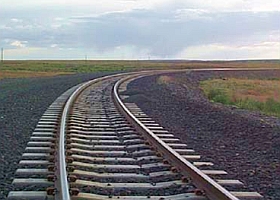Research underway at Kansas State University in Manhattan aims to improve the durability of railroad ties designed for high speed rail systems in the U.S. and elsewhere. The work led by Kansas State engineering professor Kyle Riding is funded in part by a $1.2 milion grant from the Federal Railroad Association, an agency of the U.S. Department of Transportation.
Riding, with colleagues from Kansas State, University of Illinois, Canadian National Railroad, and CXT Concrete Ties in Washington State and Arizona, are studying the stress of freezing and thawing weather conditions on concrete railroad ties built to support high-speed rail operations. “Freeze-thaw,” notes Riding, “is a stressor that happens in pretty much all concrete when it is exposed to water and then freezing and thawing temperatures.”
The volume of water expands by some nine percent as it freezes, which when coupled with melting, can cause stress on the material holding the water and lead to that material breaking under the stress. In the case of concrete rail ties, water collects and freezes in the pores of the concrete, where the freezing can create stress in the railroad tie and cause cracks. Cracks in railroad ties are problems with trains at any speed, but high-speed rail systems are more sensitive because of their higher speeds.
In the study of freeze-thaw conditions in concrete rail ties, Riding’s team will mix surfactants — that suspend substances in fluids in much the same way as soap — to the concrete in the lab. These surfactants can produce millions of microscopic bubbles in the concrete that act as pressure release valves to help protect the concrete against damage. The research aims to ensure that the bubbles are evenly dispersed through the concrete rail ties and small enough to protect the concrete from damage.
Researchers will first evaluate the vibration conditions and air voids created by these bubbles in rail ties produced from various other surrogate materials, such as cement paste and mortars, before scaling up to concrete. The ties will also be studied to determine if they get wet enough on the tracks to cause damage. The team plans as well to develop evaluation methods to help railroad tie manufacturers determine the freeze-thaw resistance of concrete rail ties once they are produced.
Read more:
- University Prof. Develops Lightweight Pipeline Material
- Grant to Fund Research on Earthquakes, Building Design
- Energy Efficient, Low CO2, Lower Cost Cement Developed
- University, Company Engineers Research Safer Railroad Ties
- Recycled Haitian Concrete Found Safe, Strong
* * *


 RSS - Posts
RSS - Posts
You must be logged in to post a comment.